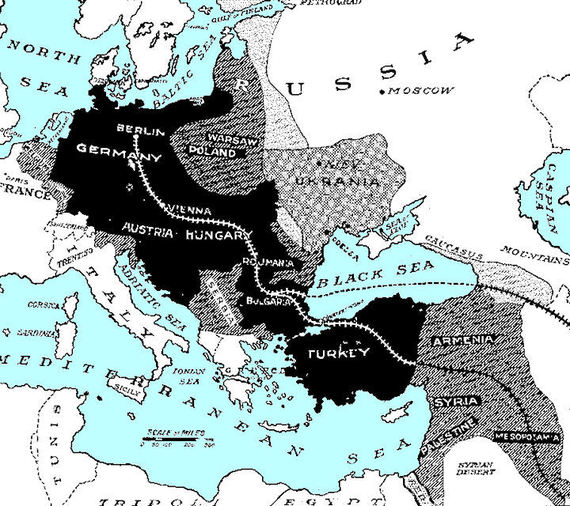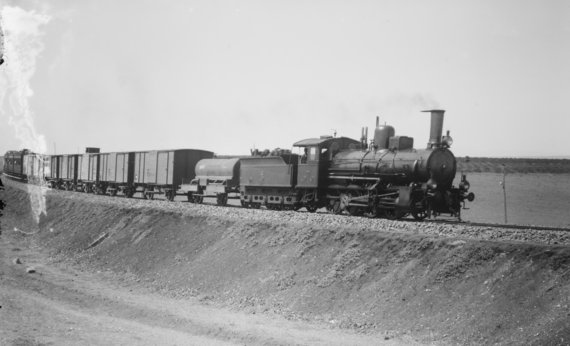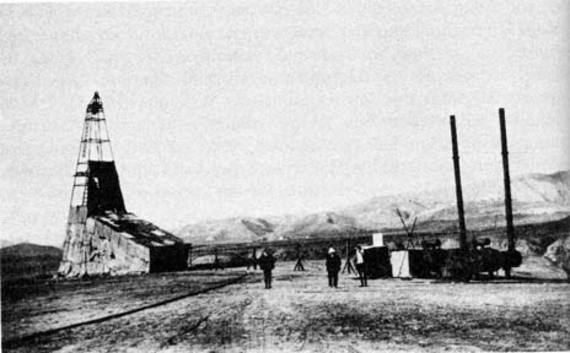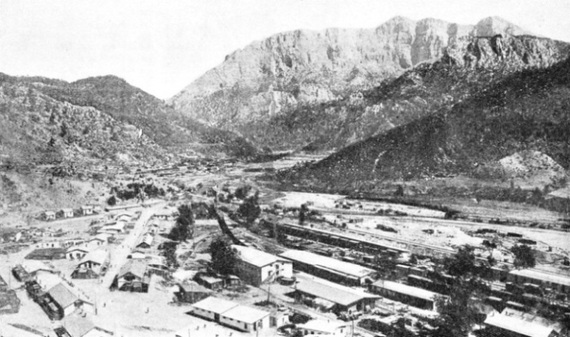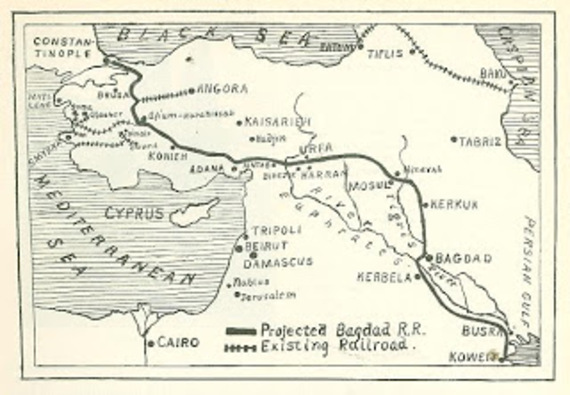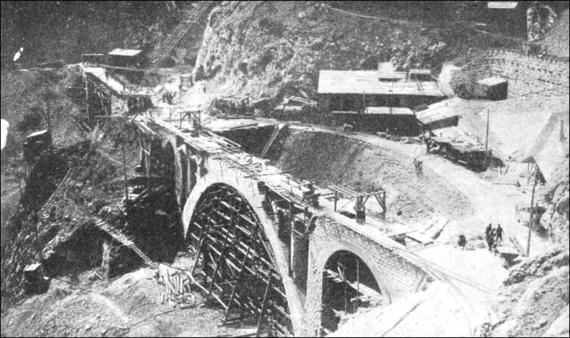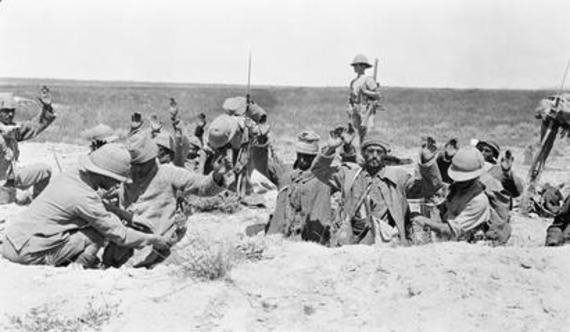The Berlin to Baghdad Railway and World War I
Route of Berlin to Baghdad Railway
The Berlin to Baghdad Railway, or Baghdadbahn, was an ambitious railroad construction project designed to link the German capital Berlin with Baghdad in the Turkish region of Mesopotamia. First conceived in 1888, and formally begun in 1903, the rail line was highly controversial, and was a source of significant diplomatic friction between Germany and the other major European powers. It has been described as an important factor in precipitating the onset of World War I. When the war started, the railroad was still approximately 600 miles from its terminus. The portion from Berlin to Constantinople, however, would prove to be a key supply route for German assistance to the Ottoman Empire and played an important role in resupplying Ottoman troops during the Gallipoli campaign in the spring and summer of 1915. Construction of the final leg was not completed until July 15, 1940. The Taurus Express made the first complete journey from Istanbul to Baghdad on July 17.
Baghdad Railway in Northern Mesopotamia
There is a great deal of misinformation regarding the Berlin to Baghdad railroad. First of all, the actual rail construction project was from Konya, a city in south central Turkey, to Baghdad. This was a distance of roughly one thousand miles and ran from Konya to Adana and from there to Aleppo, Mosul, and then Baghdad. Rail lines connecting Berlin with Constantinople already existed prior to the granting of the concession to build the railroad. From Aleppo, the rail line would link to an existing rail line to Damascus and from there with the Hejaz railroad to Amman and eventually Medina. A planned extension from Medina to Mecca, roughly 250 miles, was interrupted by the onset of the war. Although the gauges were not always consistent with other existing railroads in the Ottoman Empire, the Baghdad railroad would have provided the Ottomans an integrated network across the length of their empire.
Ottoman Railroad Network Actual and Projected in 1914
Secondly, notwithstanding its name, Baghdad was never intended to be the terminus of the proposed rail line. The intended terminus was Basra. German financial interests, led by Deutsche Bank, the main financiers of the project, intended to build a port on the Persian Gulf at the railroads terminus. The prospect of a railroad line running continuously from Berlin to the Persian Gulf and, one would surmise, a military base to defend it, was seen as an unprecedented expansion of German political, economic and military influence into the Middle East, and a direct challenge to British and Russian interests in Persia.
Discovery of Oil in Persia by the Anglo Persian Oil Company
Moreover, by the beginning of the twentieth century the growing importance of petroleum in the world economy and its prevalence in the Middle East was becoming readily apparent. British interests had begun exploring for oil in Persia in 1901. Oil was subsequently discovered there in 1908. Mesopotamia had numerous oil seeps and had been the ancient world's principal source of bitumen. The Byzantines had discovered a crude method of refining bitumen to get a more flammable distillate that they used for "Greek fire." Bitumen had been used for sealing boats and legend had it was the glue that had been used to cement the bricks to build the "Tower of Babel."
Geological surveys of Mesopotamia had concluded that significant oil deposits would likely be found there but without any transportation infrastructure in place would likely be uneconomic to exploit. The "geologists" had been dispatched by British, French, German, and American business interests and had masqueraded as archeologists to conduct their surveys. Crude oil production had already been occurring around Basra and Mosul for several centuries. More importantly, the concession to build the Baghdad Railway had included the right to exploit any mineral deposits within a 20-kilometer swath on either side of the railway. Whoever controlled the Baghdad Railway would be in an ideal position to control the future exploitation of the Mesopotamian oil fields.
Workshop Facilities During the Building of the Baghdad Railroad at Belemedik in the Taurus Mountains
A rail line from central Europe through the Balkans and Anatolia to the Persian Gulf would have represented an alternative to the Suez Canal. It would have afforded Germany closer links with its colonies in East Africa and the Far East without having to rely on using the Anglo-French controlled Suez Canal or making the long sea journey around the continent of Africa. For London, a major German military presence in the Persian Gulf "was a gun pointed at British India," and threatened the emerging Anglo-Russian duopoly in Persia.
Basra at the Beginning of World War I
Basra was poorly developed as a port as the British military discovered when they attempted to use it as the supply terminal for the Mesopotamian campaign. With German capital however, and with the prospect of significant oil discoveries along the railroad route, it would have emerged as an important, if not the dominant, financial center in the Gulf. It was British fears of German plans in the region, and the possibility that the terminus of the Berlin-Baghdad railway might extend all the way to Kuwait, (whose port facilities were better developed and which was then the dominant port in the Gulf) that had prompted Britain to extend an unofficial protectorate over Kuwait in 1899 and which it formalized in the Anglo-Ottoman Convention of 1913.
Anatolian Railway Map Showing Projected Route to Kuwait
There was one other element in the railroad concession that raised concerns in Europe's major capitals -- the so called "kilometer guarantees." In return for building and financing the railroad, the Ottoman government "guaranteed" a yearly income of 11,000 francs per kilometer of operating railway and 4,500 francs for each kilometer under construction. Under the terms of the railroad concession the Ottoman government would have had to make up any shortfall in revenues. The "guarantees" were seen in Paris and London as quite onerous. They could have resulted in the Ottoman government being so deeply in debt to the Baghdad Railway Company and its financial backers that it could have resulted in the eventual de facto "takeover" of the Ottoman Empire by German interests. At the very least, it would have placed Constantinople solidly in Berlin's political and economic orbit.
Construction of a Bridge in the Taurus Mountains, Baghdad Railway 1915
In the end the Berlin to Baghdad railway was not completed before the onset of World War I. Had the line from Constantinople to Baghdad been operating during the war, the Ottoman Empire might have been better able to resist the British advance during the Mesopotamian campaign. The subsequent British conquest of Mesopotamia, including the last minute seizure of Mosul, and the organization of that territory into what would eventually become the nation of Iraq might have taken a very different course. Northern Iraq might have remained part of the newly organized Turkish state, while southern Iraq might have become a separate British protectorate. Either way, the subsequent history of the region might have turned out very differently, a result that reverberates even now in the twenty-first century.
British Troops With Surrendering Turkish Soldiers During the Mesopotamian Campaign

